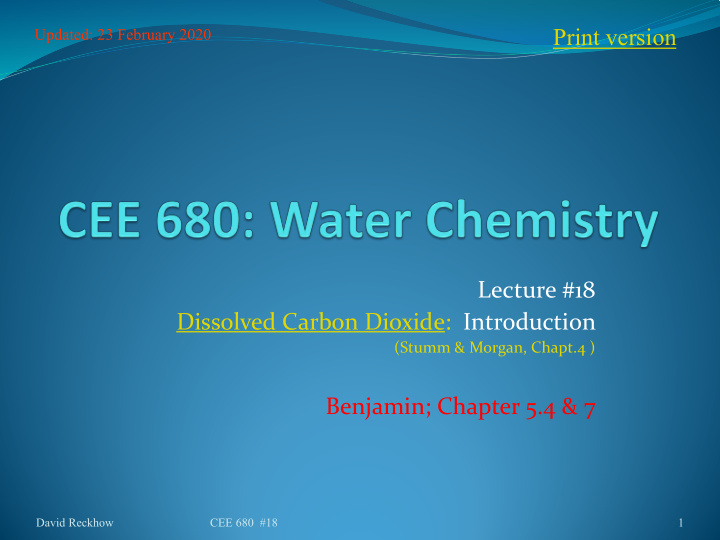



Print version Updated: 23 February 2020 Lecture #18 Dissolved Carbon Dioxide: Introduction (Stumm & Morgan, Chapt.4 ) Benjamin; Chapter 5.4 & 7 David Reckhow CEE 680 #18 1
An Aquatic Humic “Structure” Hydroxy Acid OH COOH From Thurman, 1985 HO COOH COOH Aliphatic HOOC Dicarboxylic Phenolic-OH Acid O OH HOOC HO Aromatic Aliphatic Acid Dicarboxylic Acid H 3 CO COOH COOH Aromatic David Reckhow CEE 680 #18 2 Acid
Titration of Humics Model for aquatic humic substances Acetic acid + phenol David Reckhow CEE 680 #18 3
Acid Neutralizing Capacity Net deficiency of protons with respect to a proton reference level when the reference level is H 2 CO 3 , the = f x ANC=Alkalinity [ ] ∫ = β ANC dpH = f n conservative, not affected by T or P In a monoprotic system: [ANC] = [A - ] + [OH - ] - [H + ] = C T α 1 + [OH - ] - [H + ] David Reckhow CEE 680 #18 4
Dissolved Carbon Dioxide Importance regulating pH in natural waters, also source of carbon for autotrophic organisms Sources volcanism, combustion, respiration, weathering Alkalinity Base Acid Hardness CaCO 3 (s) + CO 2 + H 2 O ←→ Ca +2 + 2HCO 3 - Sinks photosynthesis, precipitation David Reckhow CEE 680 #18 5
Major Forms of Carbon on Earth Source Mass, Percent 15 Kg 10 Geologic inorganic 60,000 83% minerals Geologic organic 12,000 17% a minerals Oceanic inorganics 40 0.056 Atmosphere 0.7 0.00097 All life on earth 0.6 0.00083 Ray, Table 3.3, pg. 37 David Reckhow CEE 680 #18 6
Carbon Forms: Definitions Inorganic Carbon CO 2 = carbon dioxide (dissolved and gas) H 2 CO 3 = carbonic acid (dissolved) HCO 3 - = bicarbonate (dissolved) CO 3 -2 = carbonate (dissolved) CaCO 3 = calcium carbonate (mineral) Organic Carbon C 6 H 12 O 6 = glucose (a sugar) CH 3 COOH = acetic acid (a carboxylic acid) David Reckhow CEE 680 #18 7
The Carbon Cycle After: Ray, Figure 3.9 Atmospheric Combustion CO 2 Plant Consumption Animal Organic-C Organic-C Fossil fuel Dissolution Aqueous Geologic Organic-C Carbonates carbonates Precipitation David Reckhow CEE 680 #18 8
Global Carbon Dioxide Atmospheric carbon dioxide, ppm. https://www.esrl.noaa.gov/gmd/ccgg/trends/ David Reckhow CEE 680 #18 9
TOC Trends in US Rivers Reckhow, Rees & Nusslein, 2006 David Reckhow CEE 680 #18 10
Lake Erie Total Organic Carbon levels from 2004 to 2011 in the Western Basin of Lake Erie (Baldwin Raw) and in treated water (Baldwin FE) David Reckhow CEE 680 #18 11
Tri-state Region The Northeast Climate Change Report has projected increases in temperature of 8- 12ºF in winter and 6-14°F in summer based on the higher emissions scenario. In general a great annual rainfall is expected, with more high flow events in winter and spring, higher intensity storms and longer annual droughts in summer. This is projected to cause a loss of spruce, fir, hemlock, maple beech and birch, and a migration to a oak/hickory forest. There may be more complete export of agriculturally-applied nutrients. The loss of hemlocks could speed up decomposition and nutrient cycling in soils, increasing nitrate runoff into streams. David Reckhow CEE 680 #18 12
To next lecture David Reckhow CEE 680 #18 13
Recommend
More recommend